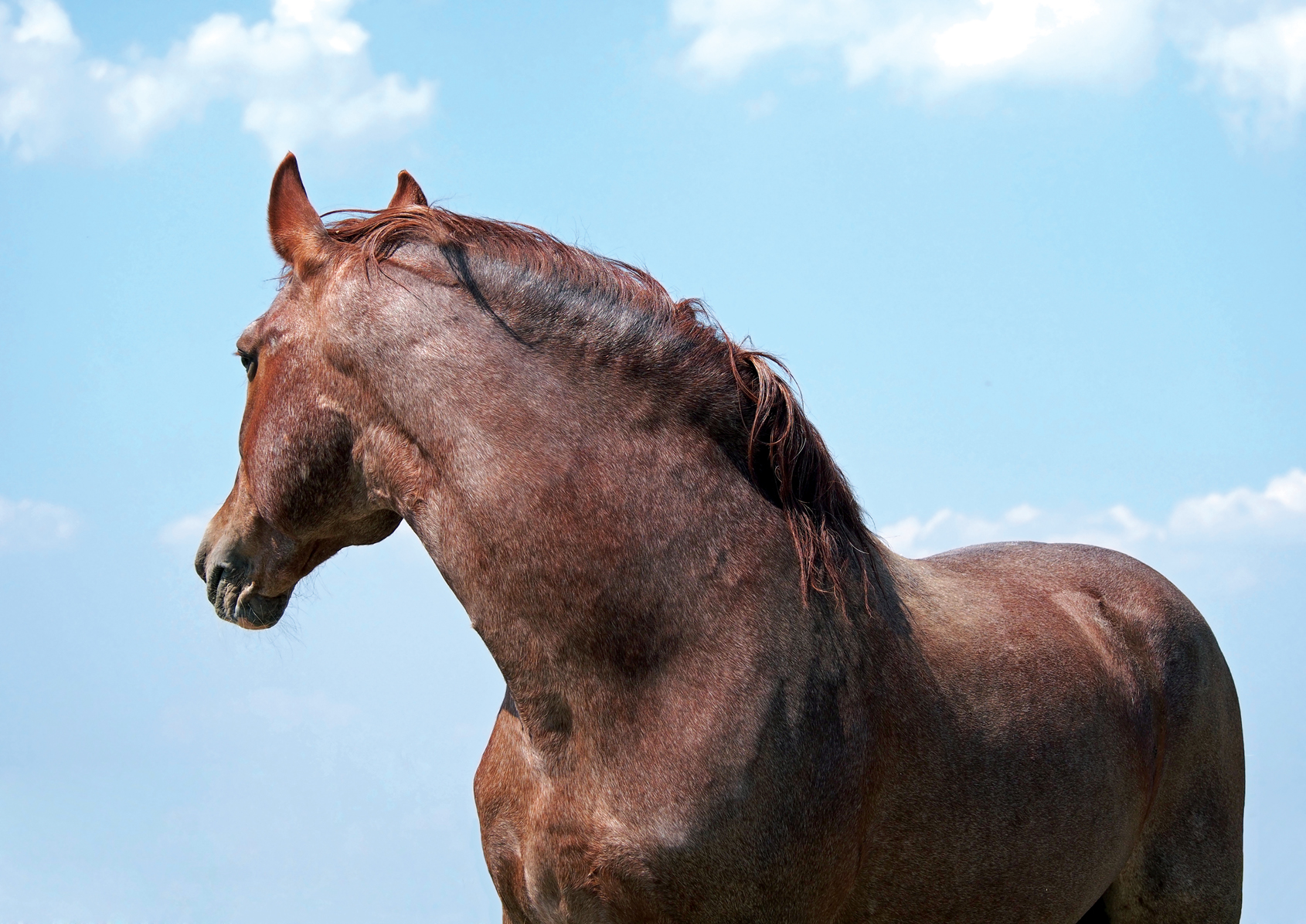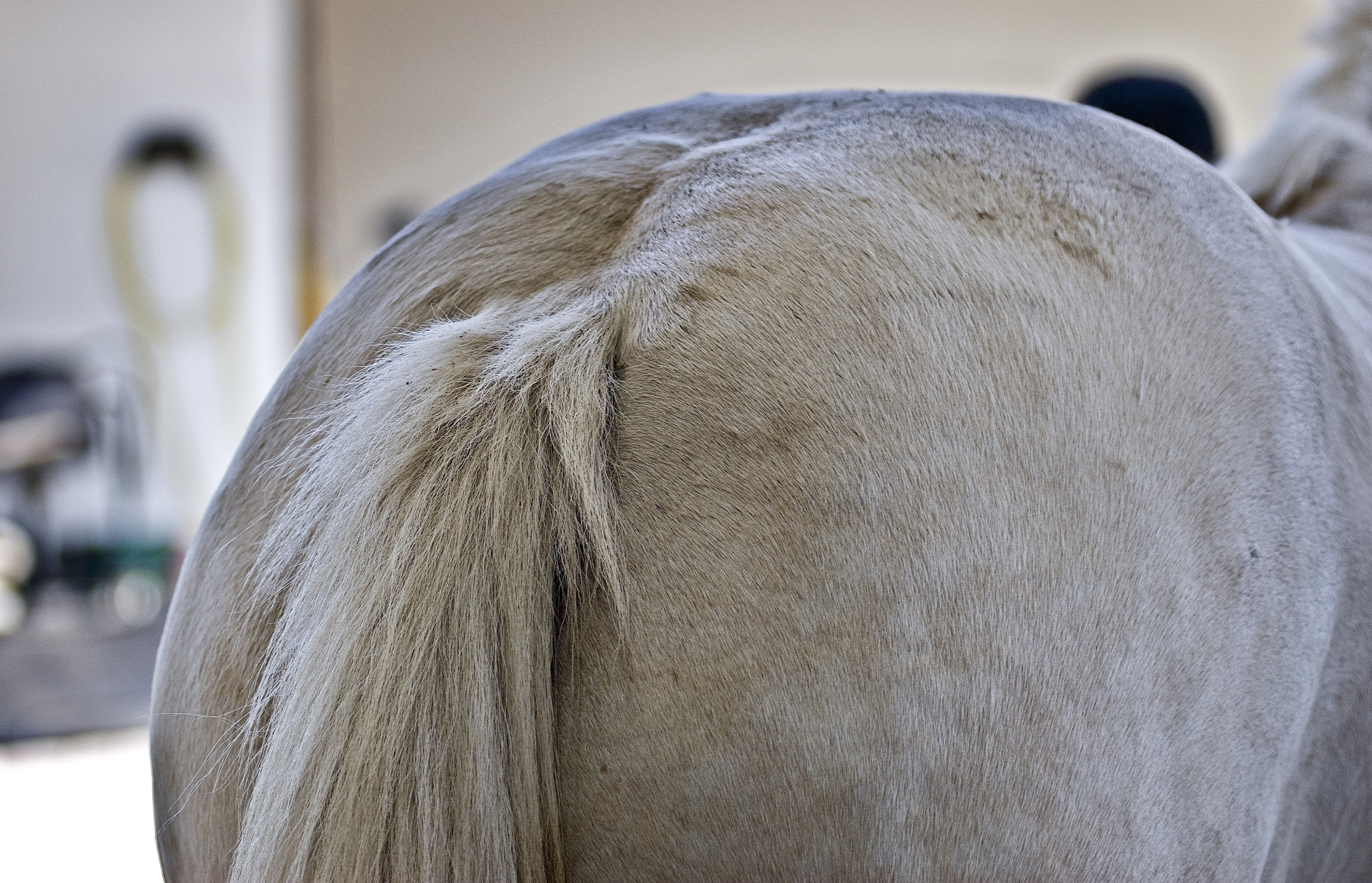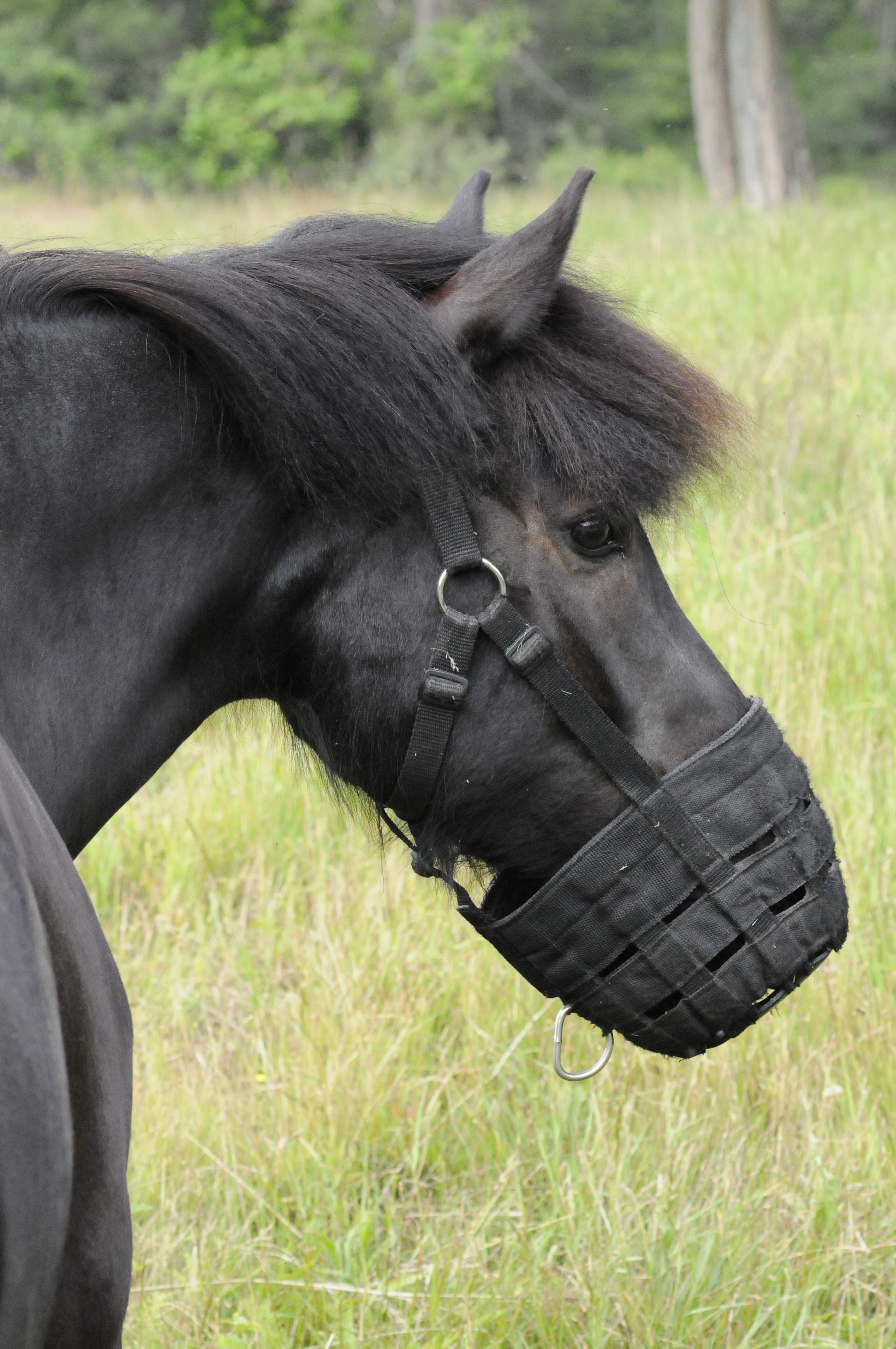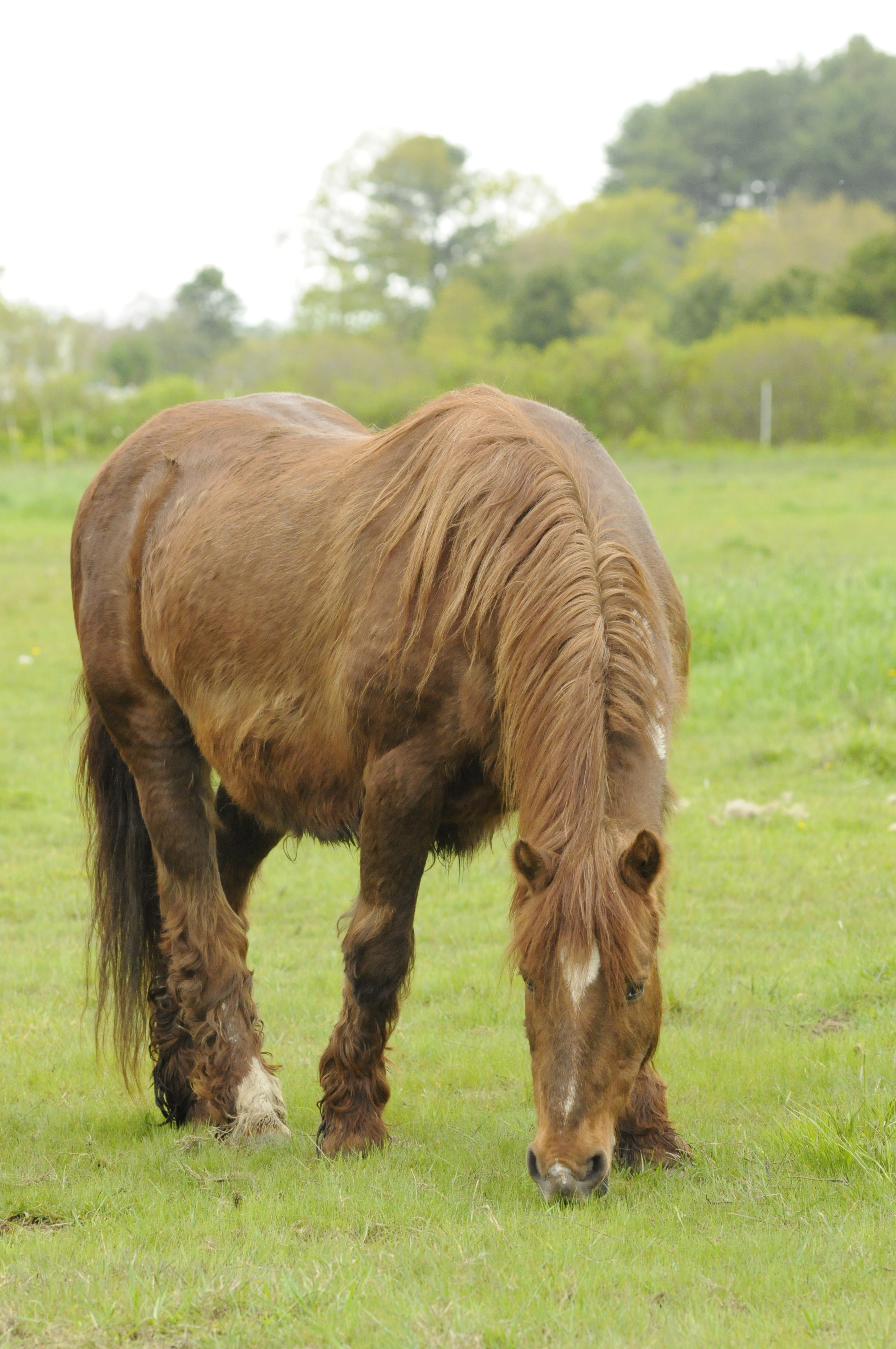
Photo: Fotolia
He looks ‘healthy,’” your trainer says of your horse, who has recently packed on a few extra pounds. Although you laugh off the comment, you wonder why reducing his feed and adding a few more minutes to his trot sets and flatwork hasn’t slimmed him down at all. It’s possible the answer lies not in his meal size or exercise regime but in his bloodstream. He may be experiencing the effects of an endocrine disorder called equine metabolic syndrome, which affects his ability to metabolize food properly.
The endocrine system is made up of multiple organs, glands and tissues whose primary roles are hormone production and regulation. When these hormones are released into the body, they power many systems, such as reproduction, growth and metabolism. When the endocrine system isn’t functioning properly, it can lead to complications. In horses, one of the most common endocrine disorders is EMS, which can be a serious health risk if it is not treated and left unmanaged.
EMS occurs in young to middle-aged horses and is most commonly seen in breeds that you might call “thrifty” or “easy keepers,” such as Morgans, Andalusians, Arabians, Paso Finos, ponies, miniatures and warmbloods. Research indicates that breeds like these are at a higher risk of EMS due to genetic predisposition.
“These are in many respects good genes,” says Nicholas Frank, DVM, PhD, DACVIM, a professor of Cummings School of Veterinary Medicine at Tufts University. “They were genes that allowed these breeds to survive. The pony that could put on a lot of weight would then survive long winters when there wasn’t much available to eat. The genes stayed in the bloodlines because the horses could survive.”
Scientists and veterinarians are still trying to understand the exact nature of these hereditary connections as well as why some horses are more severely affected by EMS than others. Despite the remaining unknowns, the disorder can be effectively treated and even prevented through horse management and nutrition control.

© Paula Da Silva/Arnd.nL
Recognizing Early Signs
The primary characteristic of EMS is insulin resistance, now more commonly referred to as insulin dysregulation. The horse’s pancreas, an important organ of the endocrine system, produces and regulates the release of insulin, a hormone that functions to metabolize and balance the body’s main source of fuel, glucose. Glucose is a sugar converted from carbohydrates in forage and grain. The more glucose there is in a horse’s diet, the more insulin the pancreas produces. Horses with EMS produce too much insulin. Over time, their bodies stop responding, or become resistant, to the hormone’s effects, so their pancreases have to produce even more insulin to be effective.
“In any horse, insulin concentrations are going to go up after they feed, but in the horse with insulin dysregulation, those insulin concentrations go up much higher,” Dr. Frank says. Insulin causes glucose to go into the tissues, where it is used to power bodily functions or is stored as fat, he explains. “While EMS horses are able to do this and maintain glucose concentrations in normal range, they have to secrete a lot more insulin to do so.”
Because insulin stimulates conversion of glucose into fat, high concentrations of it may even promote excess fat accumulation. Clinical signs associated with EMS include obesity, difficulty losing weight, easily gaining weight and the development of fatty deposits, particularly in the crest of the neck. EMS horses may also have increased inflammatory responses.
Obesity commonly associated with EMS horses can have negative effects on the body, including the formulation of pedunculated lipomas (benign tumors on the connective tissue of the intestine), which can lead to intestinal colic. The added weight on joints and other musculoskeletal structures can also be damaging to horses. In addition, high levels of insulin concentrations are thought to be related to changes in mares’ reproductive cycling, which may decrease the likelihood of conception.
The most serious effect of unhindered EMS is laminitis, a painful and potentially life-threatening condition of the horse’s feet. Laminitis is the breakdown of laminae, the internal structures that hold the wall of the hoof to the coffin bone. This produces lameness and downward rotation of the coffin bone, and in very severe cases, it may even cause the wall and the bone to separate. The connection between high levels of insulin and laminitis is still unclear, but the risk is real and can affect a horse’s quality of life.
“It isn’t always their endocrine system we’re left managing after a bad bout of laminitis; it’s the structural damage to the feet,” Dr. Frank says.
Simple Blood Tests Diagnose EMS
EMS can be definitively diagnosed with simple blood tests. Clinicians and researchers in the Equine Endocrinology Group, of which Dr. Frank is a member, work together to advance the understanding of endocrine disorders in horses. They update their website (www.sites.tufts.edu/equineendogroup) every two years with diagnostic recommendations based on the latest endocrine-disorder research. Currently, the group recommends two blood tests for diagnosing EMS: the oral sugar test and the insulin tolerance test. Both can be performed at the barn and are inexpensive.
Oral Sugar Test: This is the test most commonly used for diagnosing EMS, as it replicates what happens to an individual horse’s glucose levels when he eats and, consequently, can evaluate his natural insulin response. It calculates how much insulin is produced as a result of a measured dose of glucose being delivered into the body. The horse must fast for six hours first. Then the test is performed by administering corn syrup by mouth. To measure the subsequent increase of insulin concentrations, blood samples are taken at 60 and 90 minutes after the corn syrup is given. If the horse has insulin dysregulation, his insulin concentrations will go up higher than a normal horse’s would in that period of time.
Although laminitis has been associated with instances of high sugar intake (for example, from a grain overload), Dr. Frank stresses that neither he nor his colleagues have ever observed a horse with EMS develop laminitis after an oral sugar test. However, if you are concerned about giving sugar to a horse who might have EMS, a resting insulin concentration test can be performed instead. This involves taking a single sample of blood to measure insulin levels. A positive result will confirm the diagnosis, but negative results are not conclusive, so experts still recommend performing an oral sugar test if the resting insulin concentration test produces a negative result.
Insulin Tolerance Test: Unlike the oral sugar test, the insulin tolerance test does not require a horse to fast first so can be done spontaneously or on short notice. The insulin tolerance test is performed by drawing blood and checking a horse’s glucose level. The veterinarian then injects the horse with a small amount of insulin and, after 30 minutes, draws blood to measure the glucose level again. If the blood glucose level decreases by less than 50 percent, the horse is considered positive for insulin dysregulation. A decrease of blood glucose levels by more than 50 percent is considered normal, but your vet may still recommend an oral sugar test in order to confirm the horse’s health. Note: There is a small risk of the horse developing hypoglycemia (low blood sugar) with the insulin tolerance test.
Dr. Frank recommends performing one of these blood tests annually to check your horse’s insulin status, especially if he is being treated for EMS or is a high-risk breed or has a known hereditary connection. Testing your horse when he receives his spring vaccinations is convenient. This is also when the grass is lush, growing rapidly and contains a high sugar content, so insulin dysregulation is more likely during this time.
Amanda Adams, PhD, associate professor of veterinary science at the University of Kentucky’s Gluck Equine Research Center, agrees: “Don’t guess. Test. Be proactive before they’re even metabolic or showing signs of obesity. Follow their insulin levels over time. It’s a gradual change, but it can sneak up on you.”

© Dusty Perin
Drastic Management Adjustments
If your horse is diagnosed with insulin dysregulation, an immediate diet change is required to reduce the amount of sugar and carbohydrates in his diet, which will, in turn, keep his glucose levels down. How drastically you need to change his diet depends on the severity of his condition. The blood tests will indicate where he falls on the spectrum, but any signs of laminitis (a strong digital pulse, distorted hoof shape, rings on the hoof wall, shortened stride, unusual weight shifting, reluctance to walk, visible lameness) should be considered serious.
If your horse is diagnosed as severely insulin-dysregulated based on the results of the blood test and is also obese, the Equine Endocrinology Group currently recommends starting him on an initial hay-based diet and excluding grain completely. Restrict turnout to a dry lot or a small paddock with little grass. Sugar concentrations in grass are higher in the middle of the day, so consider turning him out only at night or in the morning. If he is obese, feed him only 1.5 percent of his body weight in hay daily for 30 days. You can spread this hay ration over two or three feeding periods per day or put it in a slow-feeder haynet.
Experts recommended feeding EMS horses hay that is low in nonstructural carbohydrates—sugar and starch. Many factors affect the NSC levels of hay, so the only way to know for sure is to have it tested. Then consult your veterinarian about the results. If you are unable to test the sugar levels of your hay, soak each of your horse’s hay meals in water for at least 30 to 60 minutes, then drain it before feeding. This will remove a substantial amount of sugars.
“Weigh the horse and weigh the flakes of hay so you know exactly how much you are feeding,” Dr. Adams says. “If the horse still hasn’t lost weight after a month, you can start to decrease this percentage carefully, but work with a vet/nutritionist to do so safely.”
If, by the end of the 30 days, your horse has successfully lost weight, continue the restricted diet until follow-up blood tests indicate a significant improvement.
EMS horses who are not obese or have lost the weight may be maintained on low-sugar, low-starch grain and hay. If necessary, calories may be added with high-quality fiber, such as beet pulp. Some horses may not need grain at all. Instead, they can get necessary vitamins and minerals from supplements or a ration balancer. If your horse must have grain, feed him smaller, more frequent meals per day to avoid glucose spikes.
Restricting a horse’s diet is usually not enough to treat EMS successfully. Exercise is important, as well, regardless of the severity of his condition—especially if he is overweight. Insulin-dysregulated horses have a harder time losing weight, so plenty of exercise is necessary to pull off those pounds. Dr. Adams says there is no “exact” exercise regimen guaranteed to improve insulin dysregulation. “It really is something, along with diet, that needs to be tailored to the individual horse.” (If your horse is already suffering from laminitis, talk to your vet and farrier about providing additional shoeing support and addressing how and when to exercise him.)
In some cases, medication is necessary to treat EMS. There are two medications most commonly used:
- A high dose of Thyro-L (levothyroxine sodium powder) is specifically used to help obese horses lose weight if they are unable to do so through normal management practices.
- The second drug is called metformin, which is commonly used to treat diabetes in humans. However, Dr. Frank explains, it has mixed results in horses. “It is not absorbed very well, but it is still worth attempting to use this as a treatment for a horse that is severely affected and won’t respond to management practices.”
Lifelong Maintenance
Unfortunately, an EMS horse can never be fully cured, but the disorder can be managed through proper nutrition and exercise. “The key is to recognize the risk, mitigate the risk and prevent them from developing laminitis,” Dr. Frank says.
As is often the case, the best treatment is prevention. If your horse is at risk for EMS, look out for the physical signs and have his blood regularly tested. If you catch EMS in the early stages, there is no reason why he can’t go on to live a healthy, active life.
Dr. Adams stresses that you don’t have to be in this alone. “Work with your veterinarian, nutritionist, farrier. It takes that team to help manage these horses.”

EMS or PPID?
Equine pituitary pars intermedia dysfunction is another endocrine disease, previously known as Cushing’s disease. Like EMS, PPID can lead to laminitis.
The disease also raises insulin levels, which can make equine metabolic syndrome worse.
“PPID is seen in middle-aged horses as well as the aged horse,” says Dr. Nicholas Frank. “Now we recognize horses with EMS often develop PPID. So it’s a question of finding out if there is one endocrine disorder or two endocrine disorders in the same horse. Detecting the PPID is important because we can treat that and take that factor back out of the picture.”
Dr. Frank recommends closely watching any horse or pony over the age of 10 for signs of PPID, whether or not he is predisposed to EMS. These are:
- Weight loss that can’t be explained by a change in diet or exercise. PPID causes the horse to burn more calories and become harder to keep weight on.
- Loss of topline. PPID causes muscle wasting that often begins with muscles along the back decreasing in mass.
- Any sort of hair-coat change, however subtle. Often this is the horse shedding out more slowly than others in the barn or shedding out in patches.
This article was originally published in the October 2018 issue of Practical Horseman.









